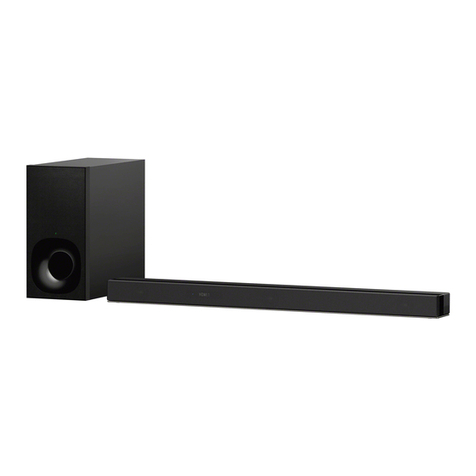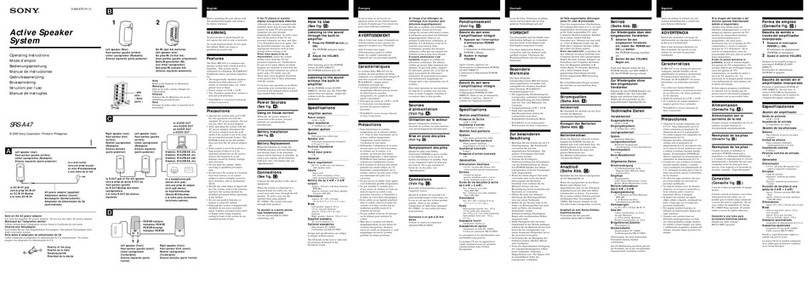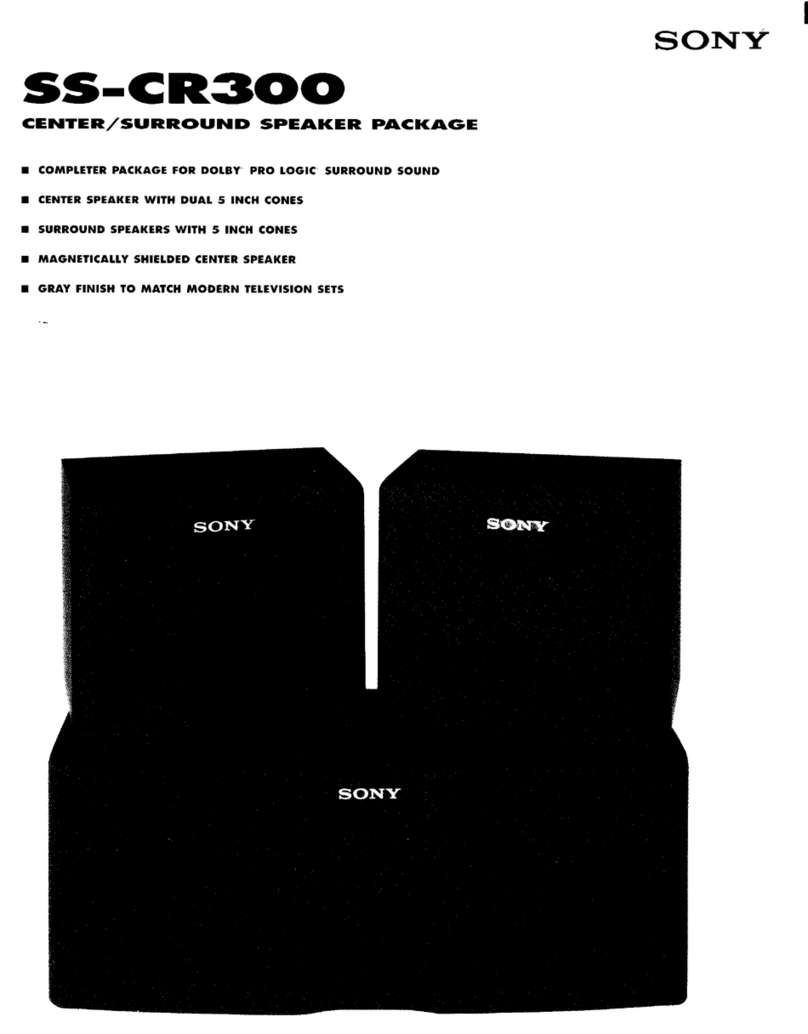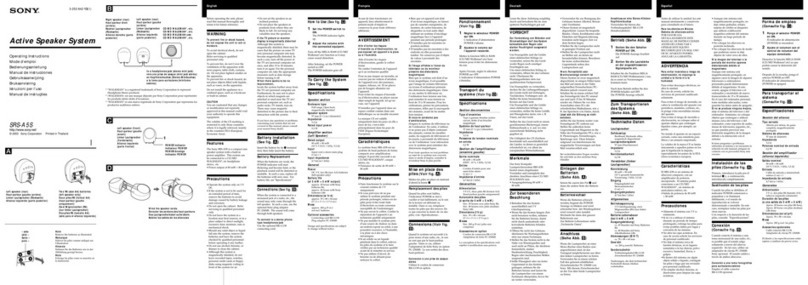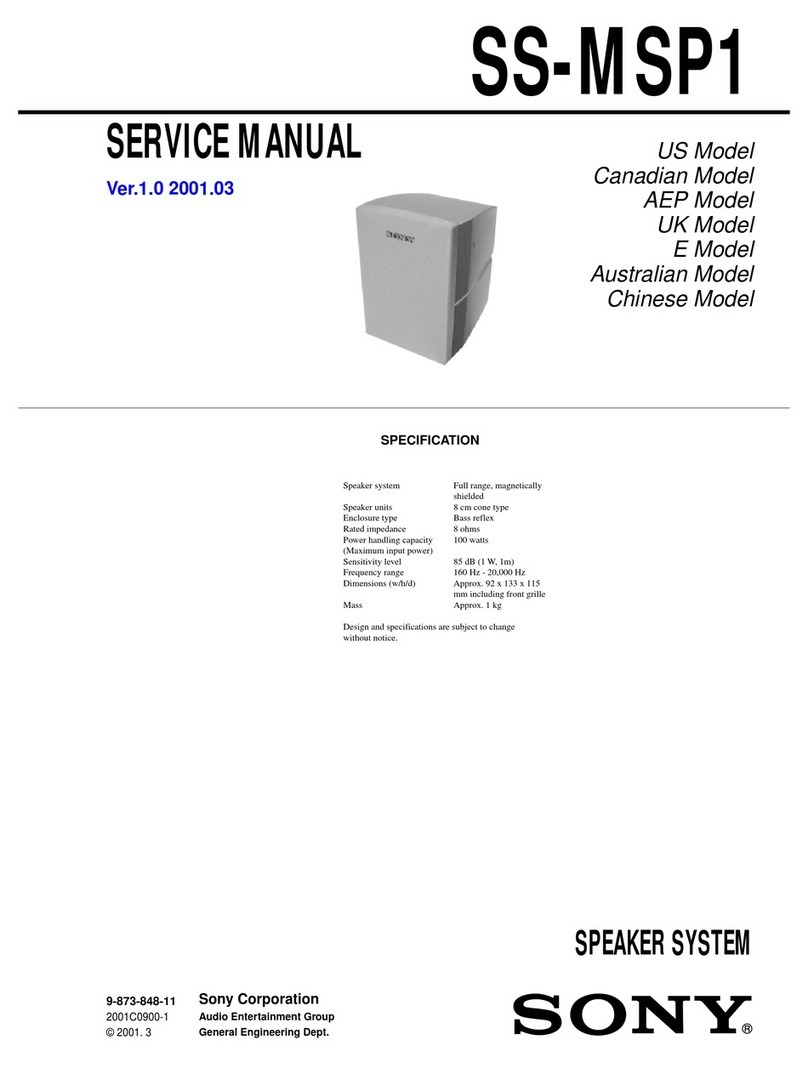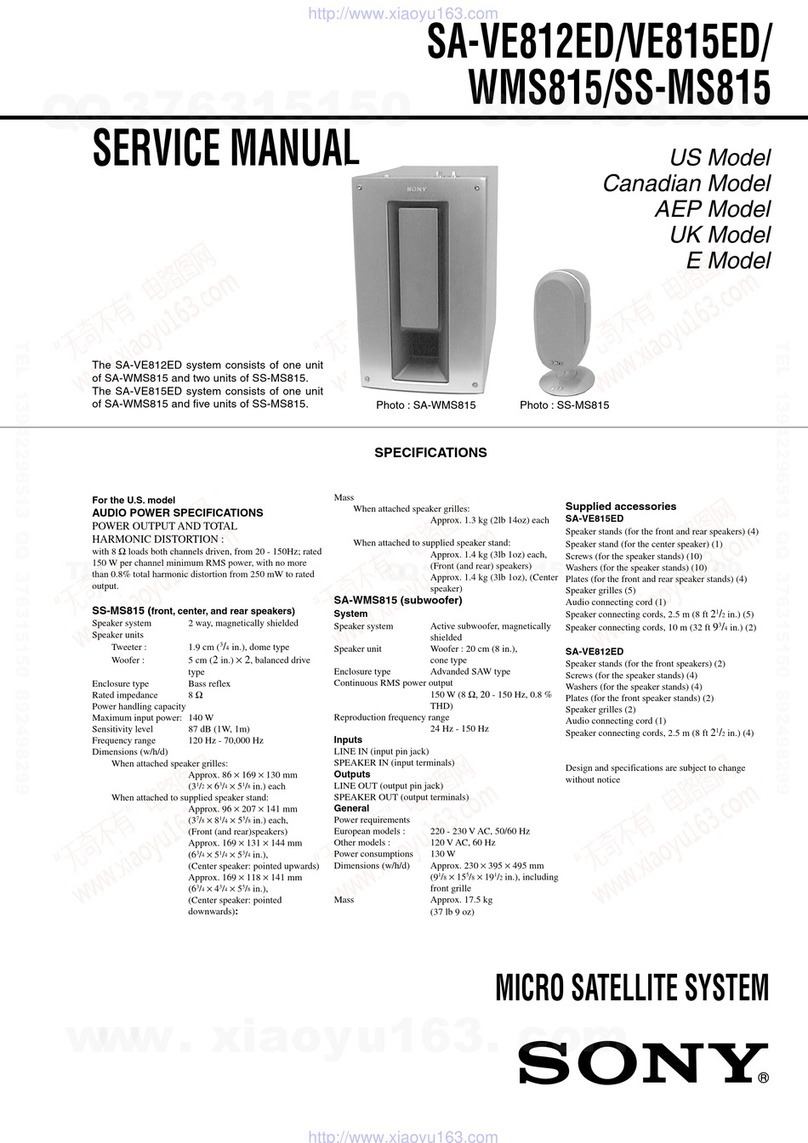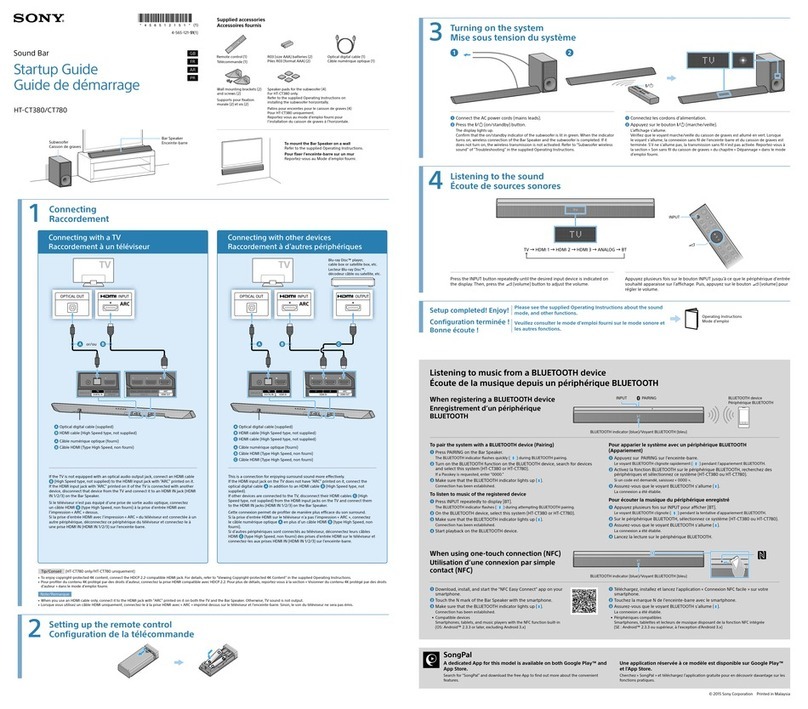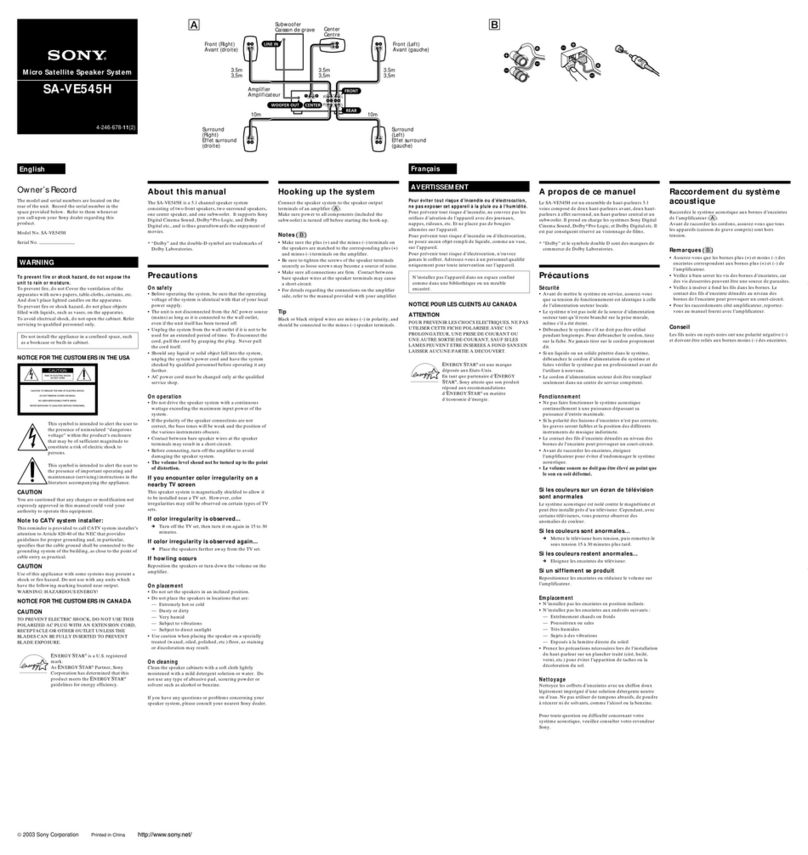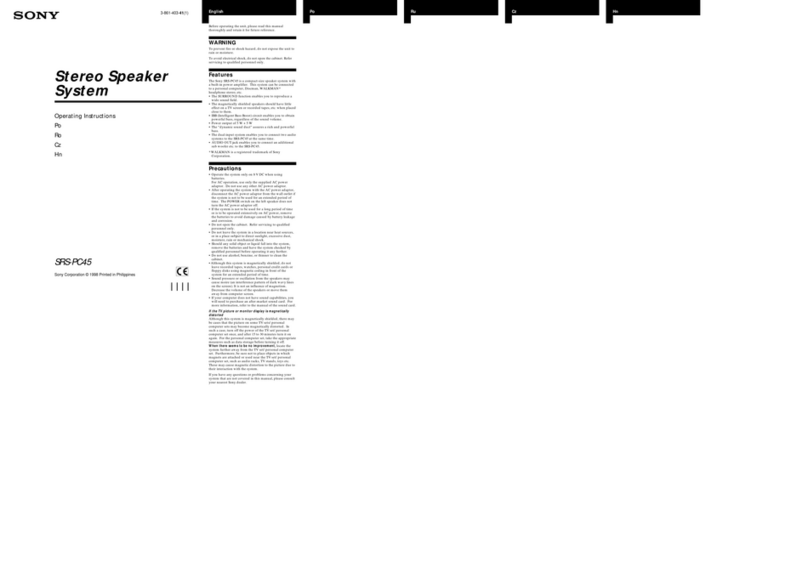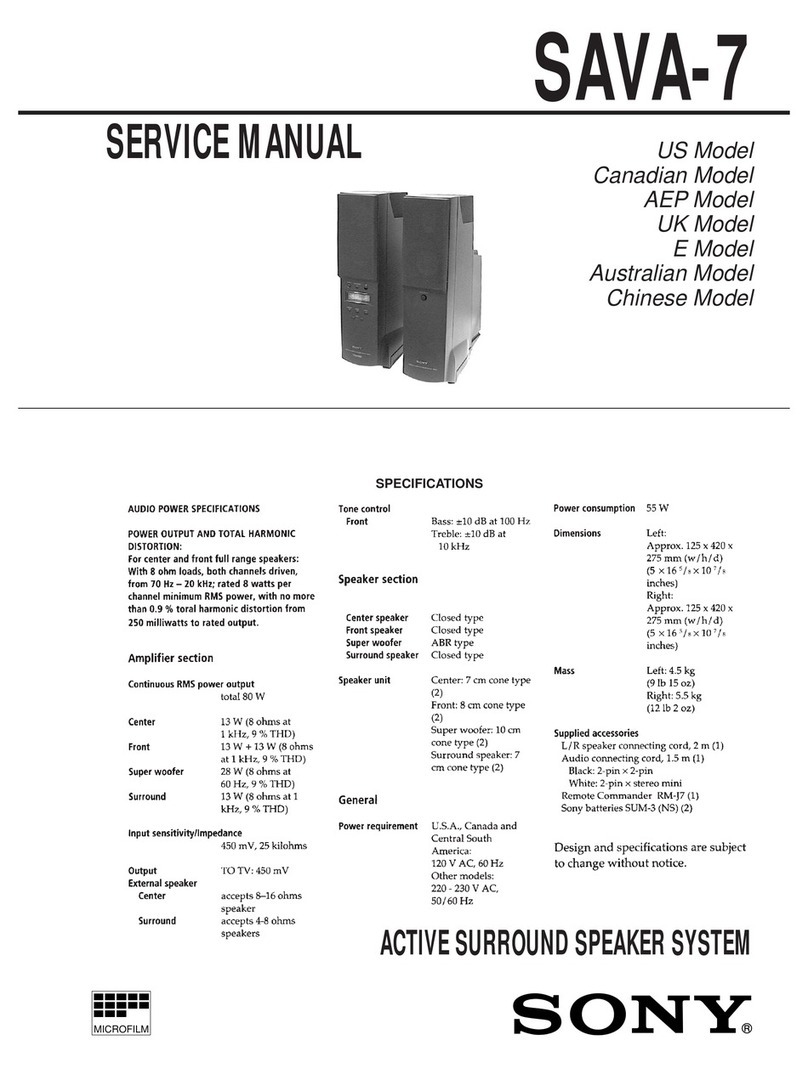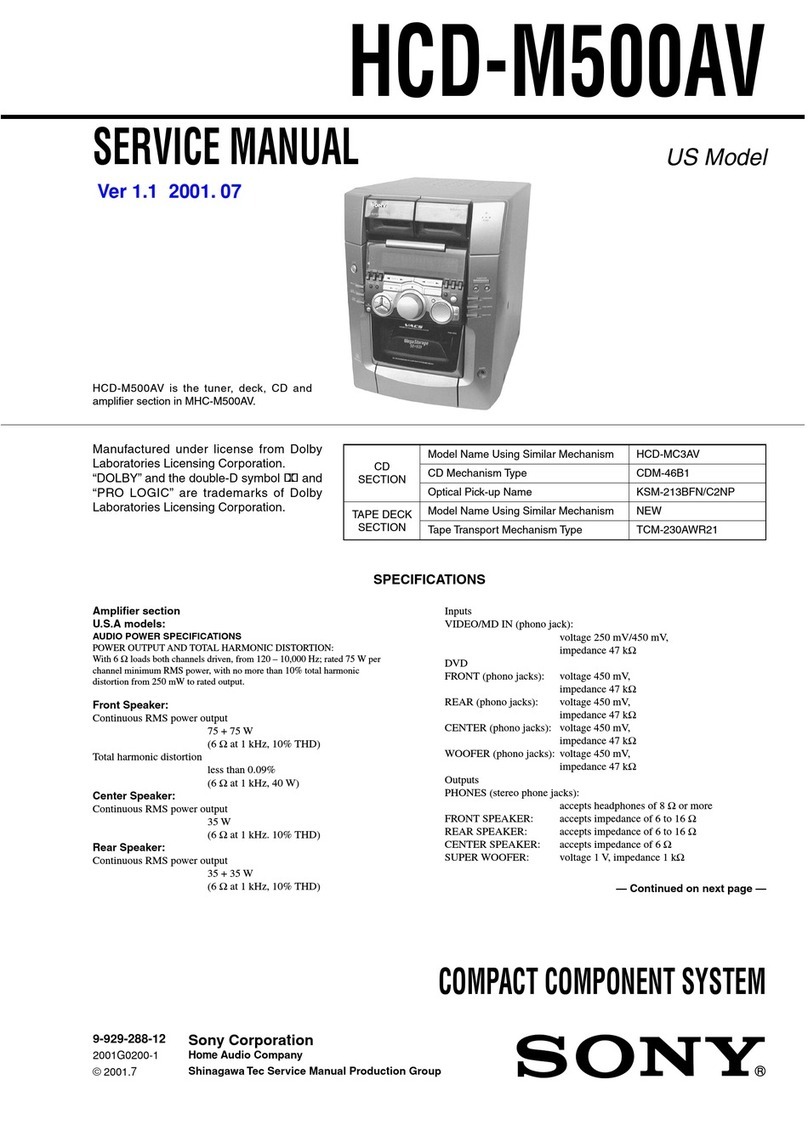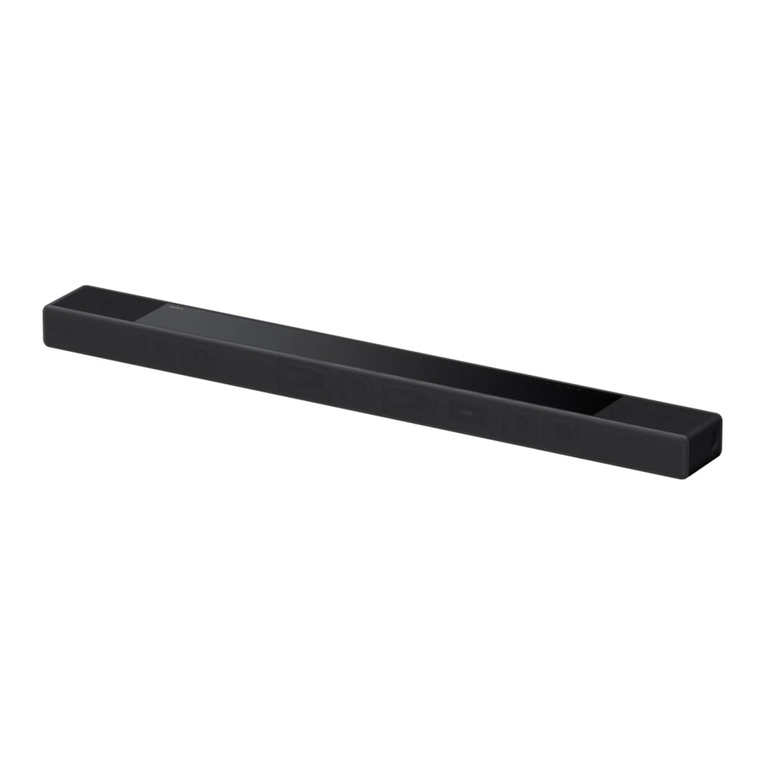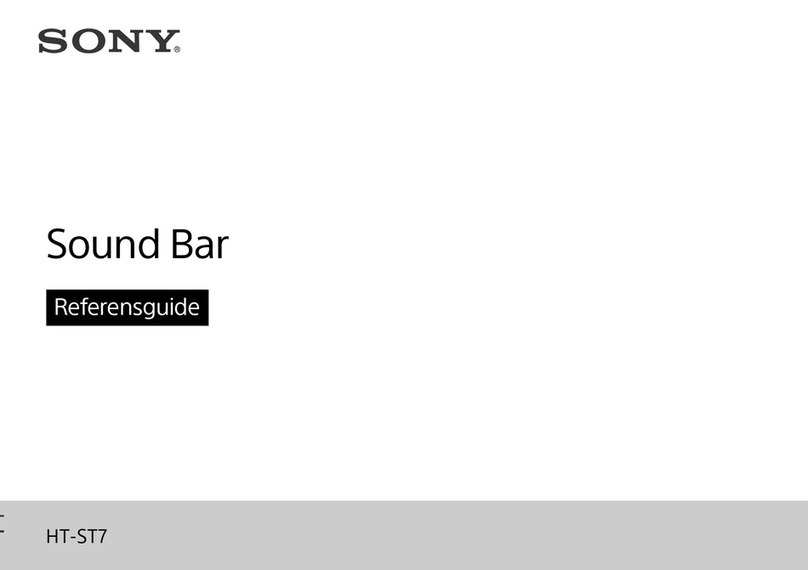
HT-NT3
2
Speaker
Woofer: 65 mm (2 5/8 in) cone type, magnetic fluid speaker ×2
Tweeter: 18 mm (23/32 in) dome type ×2
General
Power requirements
LA9 model only:
110 V – 240 V AC, 50/60 Hz
US, CND, TW models only:
120 VAC, 60 Hz
EA model only:
127 V – 240 V AC, 50/60 Hz
Except LA9, US, CND, TW, EA models:
220 V – 240 V AC, 50/60 Hz
Power consumption
On: 55 W
Standby:
0.3 W
5.5 W (EXCEPT US, CND, LA9)
Dimensions (w/h/d) (approx.)
1,070 mm × 86 mm × 65 mm.
(42 1/4 in × 3 1/2 in × 2 5/8 in) incl.
projecting parts
Mass (approx.)
3.1 kg (6 lb 14oz)
Wireless transmitter section
Communication system
Wireless Sound Specification version 3.0
Frequency band
US, CND, AEP, UK, AUS, EA, E3 models only: 5.2 GHz, 5.8 GHz
SP, TW, LA9 models only: 5.8 GHz
RU model only: 5.2 GHz
* 5.2 GHz or 5.8 GHz may not be available in some countries/regions.
Modulation method
DSSS
Video formats supported by the system
Input/Output (HDMI Repeater block)
Format 2D 3D
Frame
packing Side-by-Side
(Half) Over-Under
(Top-and-Bottom)
4096 × 2160p @ 59.94/60 Hz*1 a–– –
4096 × 2160p @ 50 Hz*1 a–– –
4096 × 2160p @ 23.98/24 Hz*2 a–– –
3840 × 2160p @ 59.94/60 Hz*1 a–– –
3840 × 2160p @ 50 Hz*1 a–– –
3840 × 2160p @ 29.97/30 Hz*2 a–– –
3840 × 2160p @ 25 Hz*2 a–– –
3840 × 2160p @ 23.98/24 Hz*2 a–– –
1920 × 1080p @ 59.94/60 Hz a–aa
1920 × 1080p @ 50 Hz a–aa
1920 × 1080p @ 29.97/30 Hz aa a a
1920 × 1080p @ 25 Hz aa a a
1920 × 1080p @ 23.98/24 Hz aa a a
1920 × 1080i @ 59.94/60 Hz aa a a
1920 × 1080i @ 50 Hz aa a a
1280 × 720p @ 59.94/60 Hz aa a a
1280 × 720p @ 50 Hz aa a a
1280 × 720p @ 29.97/30 Hz aa a a
1280 × 720p @ 23.98/24 Hz aa a a
720 × 480p @ 59.94/60 Hz a–– –
720 × 576p @ 50 Hz a–– –
640 × 480p @ 59.94/60 Hz a–– –
*1 YCbCr 4:2:0/Supported 8-bit only
*2 Supported 8-bit only
Supplied accessories
Remote control (1)
R03 (size AAA) batteries (2)
High Speed HDMI cable (1) (EXCEPTAEP, UK)
Optical digital cable (1) (AEP, UK)
Stands (2)
AC plug adaptor (2) (LA9)
Design and specifications are subject to change without notice.
• Abbreviation
AUS : Australian model
CND : Canadian model
E3 : 240V AC area in E model
EA : Saudi Arabia model
LA9 : Latin-American model
RU : Russian model
SP : Singapore model
TW : Taiwan model
Copyrights and Trademarks
• This system incorporates Dolby* Digital and the DTS** Digital Surround System.
* Manufactured under license from Dolby Laboratories. Dolby and the double-D
symbol are trademarks of Dolby Laboratories.
**For DTS patents, see http://patents.dts.com.
Manufactured under license from DTS Licensing Limited. DTS, DTS-HD, the
Symbol, & DTS and the Symbol together are registered trademarks of DTS,
Inc. © DTS, Inc. All Rights Reserved.
• This system incorporates High-Definition Multimedia Interface (HDMI™)
technology.
The terms HDMI and HDMI High-Definition Multimedia Interface, and the HDMI
Logo are trademarks or registered trademarks of HDMI Licensing LLC in the
United States and other countries.
• “BRAVIA” is a trademark of Sony Corporation.
• “PlayStation” is a registered trademark of Sony Computer Entertainment Inc.
• Wi-Fi®, Wi-Fi Protected Access®, Wi-Fi Alliance®and Wi-Fi CERTIFIED
Miracast®are registered trademarks of Wi-Fi Alliance®.
• Wi-Fi CERTIFIED™, WPA™, WPA2™, Wi-Fi Protected Setup™ and Miracast™
are trademarks of Wi-Fi Alliance®.
• The N Mark is a trademark or registered trademark of NFC Forum, Inc. in the
United States and in other countries.
• Android™ is a trademark of Google Inc.
• Google Play™ is a trademark of Google Inc.
• Google Cast™ is a trademark of Google Inc.
• Google Cast™ Ready and the Google Cast Ready badge are trademarks of Google
Inc.
• “Xperia” is a trademark of Sony Mobile Communications AB.
• The BLUETOOTH®word mark and logos are registered trademarks owned by
Bluetooth SIG, Inc. and any use of such marks by Sony Corporation is under
license. Other trademarks and trade names are those of their respective owners.
• LDAC™ and LDAC logo are trademarks of Sony Corporation.
• “DSEE HX” is a trademark of Sony Corporation.
• MPEG Layer-3 audio coding technology and patents licensed from Fraunhofer IIS
and Thomson.
• Windows Media is either a registered trademark or trademark of Microsoft
Corporation in the United States and/or other countries.
This product is protected by certain intellectual property rights of Microsoft
Corporation. Use or distribution of such technology outside of this product is
prohibited without a license from Microsoft or an authorized Microsoft subsidiary.
• Opera®Devices SDK from Opera Software ASA. Copyright 1995-2013 Opera
Software ASA. All rights reserved.
• “ClearAudio+” is a trademark of Sony Corporation.
• “x.v.Colour” and “x.v.Colour” logo are trademarks of Sony Corporation.
• Apple, the Apple logo, iPhone, iPod, iPod touch, and Retina are trademarks of
Apple Inc., registered in the U.S. and other countries.App Store is a service mark of
Apple Inc.
“Made for iPod,” and “Made for iPhone” mean that an electronic accessory has been
designed to connect specifically to iPod or iPhone, respectively, and has been
certified by the developer to meet Apple performance standards. Apple is not
responsible for the operation of this device or its compliance with safety and
regulatory standards. Please note that the use of this accessory with iPod or iPhone
may affect wireless performance.
Compatible iPod/iPhone models
The compatible iPod/iPhone models are as follows. Update your iPod/iPhone with
the latest software before using with the system.
BLUETOOTH technology works with:
– iPhone
iPhone 6 Plus/iPhone 6/iPhone 5s/iPhone 5c/iPhone 5/iPhone 4s/iPhone 4/
iPhone 3GS
– iPod touch
iPod touch (5th generation)/iPod touch (4th generation)
• All other trademarks are trademarks of their respective owners.
• Other system and product names are generally trademarks or registered trademarks
of the manufacturers. ™ and ® marks are not indicated in this document.
Notice on GNU GPL/LGPL applied software and other Open Source
Softwares
This product contains software that is subject to the GNU General Public License
(“GPL”) or GNU Lesser General Public License (“LGPL”). These establish that
customers have the right to acquire, modify, and redistribute the source code of said
software in accordance with the terms of the GPL or the LGPL.
For details of the GPL, LGPL and other software licenses, please refer to [Software
License Information] in [System Settings] of the [Setup] menu on the product.
The source code for the software used in this product is subject to the GPLand LGPL,
and is available on the Web. To download, please access the following:
URL:
http://oss.sony.net/Products/Linux
Please note that Sony cannot answer or respond to any inquiries regarding the content
of this source code.
Ver. 1.1
